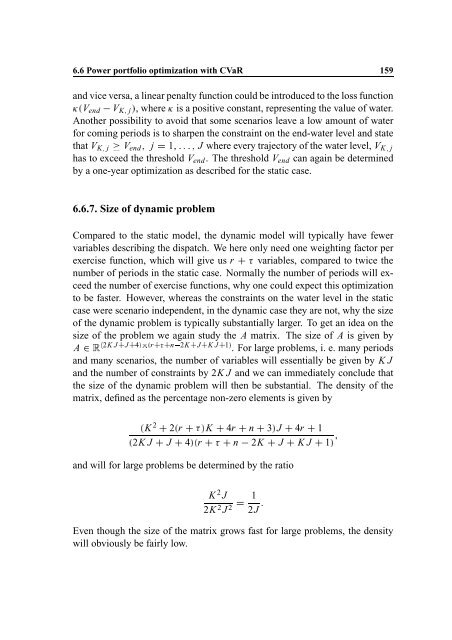Hedging Strategy and Electricity Contract Engineering - IFOR
Hedging Strategy and Electricity Contract Engineering - IFOR
Hedging Strategy and Electricity Contract Engineering - IFOR
Create successful ePaper yourself
Turn your PDF publications into a flip-book with our unique Google optimized e-Paper software.
ö<br />
Ü<br />
6.6 Power portfolio optimization with CVaR 159<br />
<strong>and</strong> vice versa, a linear penalty function could be introduced to the loss function<br />
- Û V end V Kã jÝ , where<br />
-<br />
is a positive constant, representing the value of water.<br />
Another possibility to avoid that some scenarios leave a low amount of water<br />
for coming periods is to sharpen the constraint on the end-water level <strong>and</strong> state<br />
that V K j V ã end j 1Ü Ü Ü J where every trajectory of the water level, V Kã j<br />
has to exceed the threshold V<br />
á?á@á<br />
end . The threshold V end can again be determined<br />
by a one-year optimization as described for the static case.<br />
6.6.7. Size of dynamic problem<br />
Compared to the static model, the dynamic model will typically have fewer<br />
variables describing the dispatch. We here only need one weighting factor per<br />
exercise function, which will give us r variables, compared to twice ô the<br />
number of periods in the static case. Normally the number of periods will exceed<br />
the number of exercise functions, why one could expect this optimization<br />
to be faster. However, whereas the constraints on the water level in the static<br />
case were scenario independent, in the dynamic case they are not, why the size<br />
of the dynamic problem is typically substantially larger. To get an idea on the<br />
size of the problem we again study the A matrix. The size of A is given by<br />
A<br />
2K J J 4 r n 2K J ë ë<br />
K J ë<br />
1<br />
. For large problems, i. e. many periods<br />
¢ ë ÿ ë ÿ ë ë ì<br />
<strong>and</strong> many scenarios, the number of variables will essentially be given by K J<br />
<strong>and</strong> the number of constraints by 2K J <strong>and</strong> we can immediately conclude that<br />
the size of the dynamic problem will then be substantial. ¢ The density of the<br />
matrix, defined as the percentage non-zero elements is given by<br />
Û 2Û 3Ý ôkÝ<br />
Û 4Ý?Û J ô 1Ý<br />
K 2 r K 4r n J 4r 1<br />
2K J J r n 2K J K<br />
<strong>and</strong> will for large problems be determined by the ratio<br />
K 2 J<br />
2K 2 J 2 1<br />
2J á<br />
Even though the size of the matrix grows fast for large problems, the density<br />
will obviously be fairly low.
















